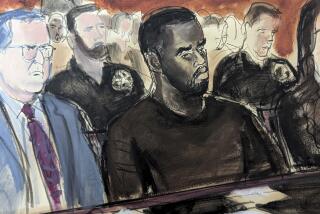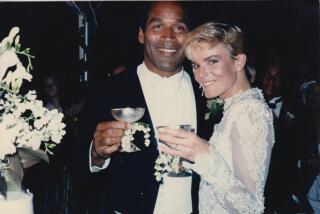Surprise Hair, Fiber Photos Anger Simpson Attorneys : Trial: Defense accuses prosecutors of violating discovery rules. Judge abruptly recesses proceedings.
- Share via
A visibly exasperated Judge Lance A. Ito abruptly recessed O.J. Simpson’s double murder trial Wednesday afternoon after prosecutors attempted to introduce photographs of hair and fiber evidence that had not previously been shown to the defense.
The photos were mounted on oversize graphic boards that prosecutors have put together to illustrate testimony by their next witness, FBI Special Agent Doug Deedrick. He is the forensic expert who analyzed the hairs and fibers the prosecution says link Simpson to the murders of his ex-wife, Nicole Brown Simpson, and her friend, Ronald Lyle Goldman.
However, shortly after Wednesday’s lunch break, as Deputy Dist. Atty. Marcia Clark prepared to call Deedrick to the stand, defense lawyers got their first look at the graphic boards and exploded into objections.
“They have committed a deliberate discovery violation of the worst kind,” said defense attorney F. Lee Bailey, who will cross-examine Deedrick. He asked Ito to bar prosecutors from displaying the boards to the jury.
Although defense experts did have several chances to study the fibers themselves, Bailey said, the photos formed a separate body of evidence that the defense needed time to examine. Withholding the photos, which were taken in December, from them for months, Bailey said, was tantamount to saying “because you visited the crime scene in person, you’re not entitled to see the photos of the crime scene” presented to the jury.
Arguing that Ito should bar the prosecution from showing the photos at all, Bailey said it would take the defense team a long time to properly study them.
“We’re at a stage in this trial where continuance is no remedy,” Bailey said. “It would just punish a jury that has been punished enough already.”
At 3:45 p.m., after listening to considerable back-and-forth between Bailey and Clark, Ito recessed the proceedings until 9 a.m. today. But he ordered that the boards be left in the courtroom so that Simpson and his attorneys could examine them. The judge also instructed Deedrick to remain behind to answer defense questions.
“I’m going to direct the prosecution to make all of these exhibits available to the defense overnight,” Ito said. “If that is still not adequate time to prepare and to compare the reports with those fibers, then I’ll consider other sanctions. I would like to finish this case sometime this lifetime.”
As he left court, Simpson’s lead defense attorney, Johnnie L. Cochran Jr., said he was “concerned about the violation of the discovery laws,” but would not comment on whether the defense team would ask for additional sanctions. “We’ll see tomorrow,” he said curtly.
The defense objections to the illustrative boards were wide-ranging and went beyond the timing of their introduction. The primary source of concern seemed to be photos of blue-black cotton fibers recovered from Goldman’s bloody shirt, the socks seized from Simpson’s bedroom and the glove found on the former football star’s Rockingham Avenue estate. One of the fibers found on Goldman’s shirt was wrapped around one of Nicole Simpson’s bloody hairs.
While going over the exhibits outside the jury’s presence, Clark appeared to suggest that the fibers could have come from dark clothing that Simpson was photographed wearing early on the night of the murders. The clothing worn by the killer has not been recovered by police.
Clark said that she will present a theory that Nicole Simpson’s hair became wrapped around a fiber of the killer’s clothing when he allegedly grabbed her by the hair before slashing her throat. According to the prosecutor’s theory, that hair-wrapped fiber was deposited on Goldman’s shirt when the killer returned to him.
When Ito expressed bewilderment as to how that could have occurred, Clark said Deedrick would explain it.
The FBI agent, who was sitting behind Clark, turned to LAPD Detective Philip L. Vannatter and whispered, “I hope.”
A Shaky End Game
Legal analysts said Wednesday’s events reflected the difficulties that prosecutors seem to be having in wrapping up their case and could not have come at a worse time.
“What happened Wednesday is symptomatic of the problems the prosecution has made for itself all through this case,” said Loyola Law School professor Laurie Levenson, a former federal prosecutor. “By not complying with the discovery rules, they may be putting the brakes on their final presentation of key evidence to the jury.”
Georgetown Law School professor Paul Rothstein agreed. “I think the prosecutors are in a terrible decline at the end of their case, which is the worst time to be in a decline,” he said. “It’s been one set of mistakes after another. All of it looks like tremendous disarray.”
As the prosecution’s case against Simpson appeared to be crawling toward a close earlier Wednesday, jurors heard another day of testimony that was literally an exercise in hairsplitting.
Over the past few days, Clark has attempted to weave 50 or so hairs and fibers collected from the crime scene, Simpson’s estate and the carpet of his white Bronco into a gossamer tapestry that prosecutors say portrays the former football star as the murderer.
On cross-examination, the defense team’s forensic evidence specialist, Robert Blasier, has reiterated a by-now-familiar theme: No matter how damning a portrait the physical evidence seems to paint, its appearance is deceiving because the items were incompetently collected and processed by the Los Angeles Police Department’s investigators and technicians, as well as by the county coroner’s office.
For example, while cross-examining LAPD criminalist Susan Brockbank Wednesday, Blasier suggested that evidence was contaminated through poor packaging. Brockbank admitted that a piece of carpet taken from Simpson’s Bronco was stored in the same evidence box as a cap and gloves collected in the case. Prosecutors say fibers from the Bronco’s carpet were found on a cap and glove recovered at the murder scene.
Today’s court day also will be abbreviated; because of a juror’s previously scheduled doctor’s appointment, Ito plans to recess the proceedings at 3 p.m.
With the jury gone for the day, Ito intends to hear arguments on a defense motion that may force prosecutors to extend their case still further. Earlier this week, Simpson’s lawyers filed papers asking the judge to compel the prosecution to call Thano Peratis as a witness. He is the Los Angeles County Jail nurse who went to police headquarters the day after the murders and drew a blood sample from Simpson, who was not yet in custody.
Unless Peratis testifies, the defense contends, prosecutors will have failed to establish the blood sample’s so-called “chain of custody,” meaning that all evidence based on the sample should be excluded.
The prosecution contends that Peratis’ testimony is not required, since he does not know precisely how much blood he took from the former football star. At Simpson’s preliminary hearing, the nurse estimated the amount at about 8 milliliters.
Police documents can account for only 6.5 milliliters of Simpson’s blood. That discrepancy is critical to the defense conspiracy theory that the police removed blood from the sample and sprinkled it on various items of evidence in an attempt to frame Simpson. Peratis’ fate was not the only uncertainty concerning what appears to be the prosecution’s end game.
On Wednesday morning, Deputy Dist. Atty. William Hodgman created a flurry of excitement when he asked for another day to produce the prosecution’s final witness list because “there are certain things going on.” Hodgman’s precise representations to Ito on the question were made at sidebar, and the transcript was sealed.
Hodgman’s comment sparked a frenzy of speculation that prosecutors hoped to wrap up their case with a surprise witness. At the lunch break, however, prosecutor Christopher A. Darden discounted the idea, saying: “There’s no new knockout evidence,” though he later amplified his comment by saying that there may be “some new witnesses.”
Ready for the Defense
With the close of the prosecution’s case apparently in mind, Simpson’s entire defense team--including his business attorney and jury consultant--huddled in the courtroom over the noon hour to plan the opening of their case. Defense sources say that the opening portion of their case will include testimony concerning Simpson’s demeanor just before and after he was informed of his ex-wife’s murder. In a motion filed this week, defense attorneys are seeking testimony from seven out-of-state witnesses. The lawyers asked Ito to certify that the seven are material witnesses necessary to the defense case, a key step in getting an out-of-state judge to order them to come here to testify, should any of the seven resist a subpoena.
Simpson flew to Chicago late on the night of the killings and returned the next day after being informed by LAPD detectives that his ex-wife had been murdered.
The seven witnesses include a Chicago hotel employee who gave Simpson a bandage for his freshly cut finger, a group of Hertz employees who met Simpson before and after he received news of the murder, the airline passenger who sat next to him on his flight home from Chicago and a travel agent who arranged his hurried trip back to Los Angeles.
But all that is to come. At the moment, it appears that prosecutors will rest sometime next week.
Times staff writer Tim Rutten contributed to this story.
* THE SPIN: Ex-juror’s book prompts intensive media interest. B1
More to Read
Sign up for Essential California
The most important California stories and recommendations in your inbox every morning.
You may occasionally receive promotional content from the Los Angeles Times.













